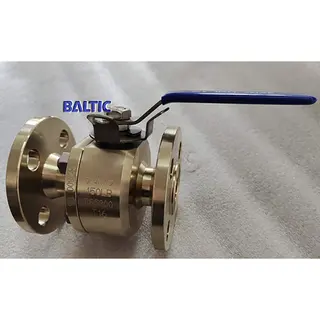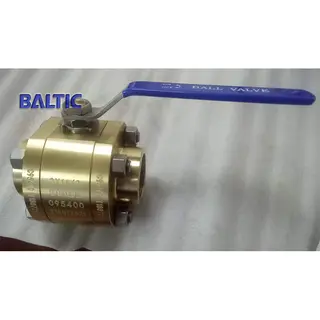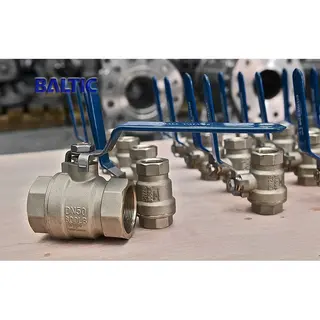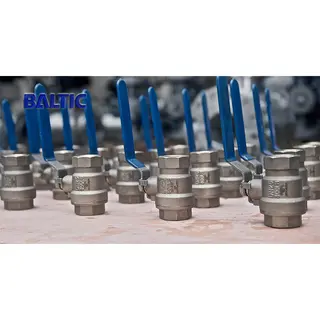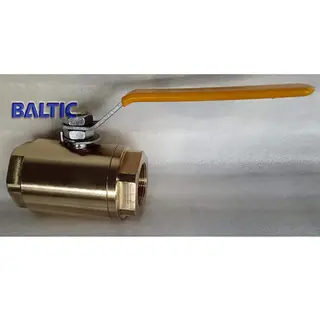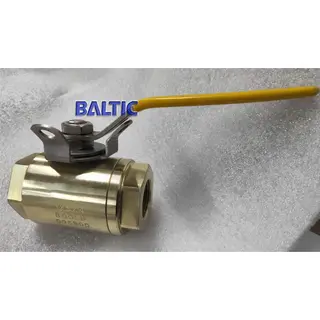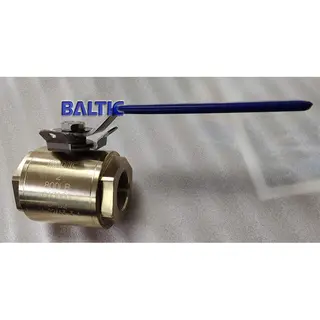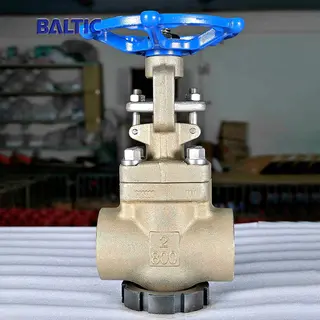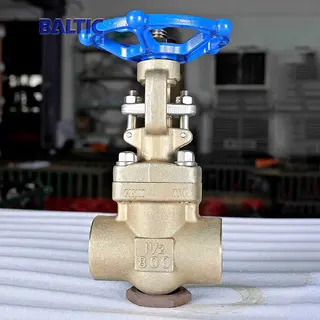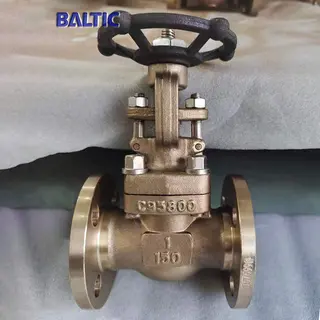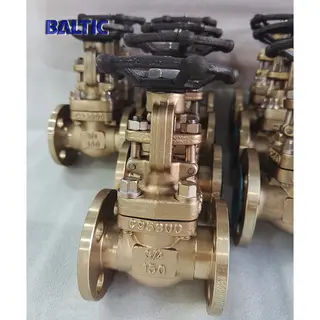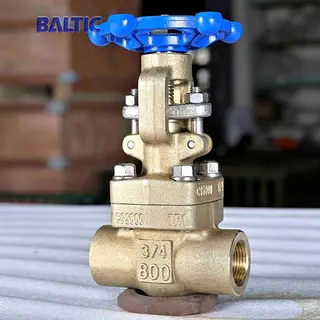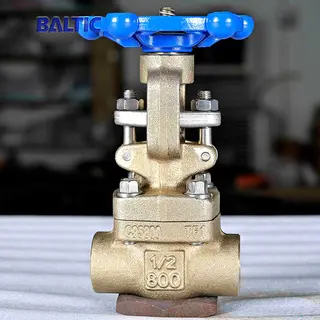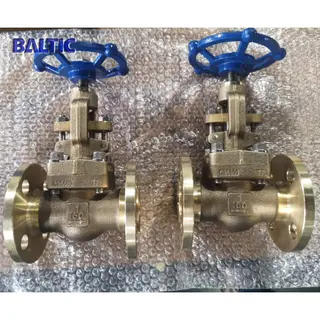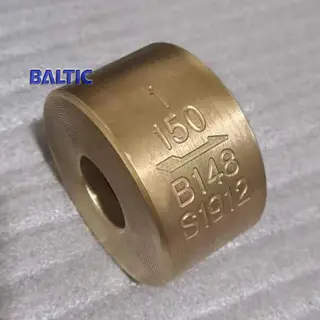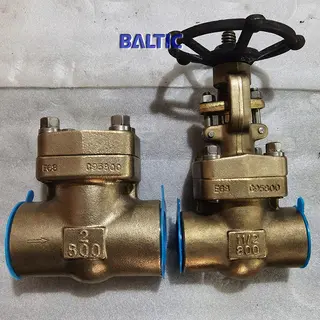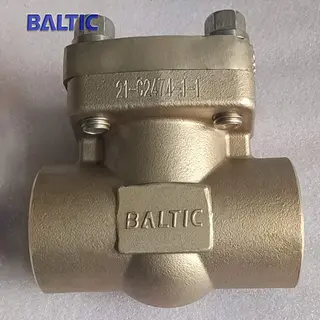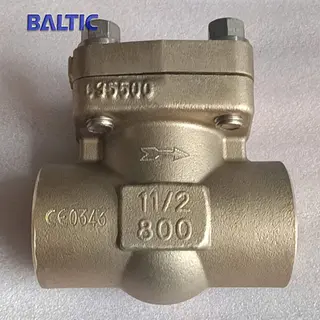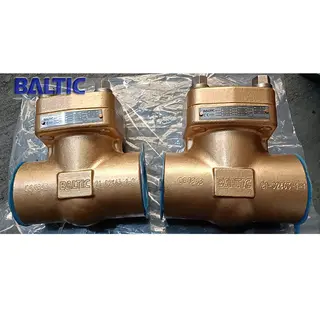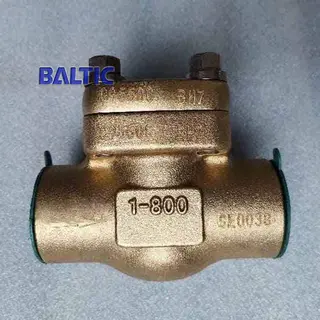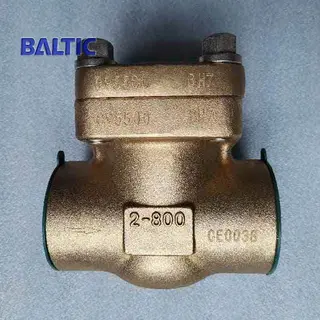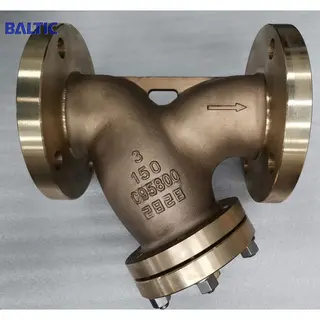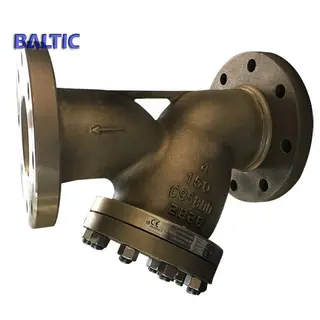Aluminum Bronze Valve
Sizes: 1/2 Inch - 60 Inch (DN15 - DN1500).
Design Pressure: Class 150 - 900 LB, PN10 - PN160.
Design Standards: EEMUA 182, ASME B16.34, API 608, API 6D.
Design Temp.: -29℃ - 260℃.
Body materials: ASTM B148 C95400, C95500, C95800, ASTM B150 C63000, C63200.
End connections: NPT, Flange.
Operation: Hand lever, gearbox, pneumatic.
Applications: for sea water, offshore and marine.
Design Pressure: Class 150 - 900 LB, PN10 - PN160.
Design Standards: EEMUA 182, ASME B16.34, API 608, API 6D.
Design Temp.: -29℃ - 260℃.
Body materials: ASTM B148 C95400, C95500, C95800, ASTM B150 C63000, C63200.
End connections: NPT, Flange.
Operation: Hand lever, gearbox, pneumatic.
Applications: for sea water, offshore and marine.
Sizes: 1/2 Inch - 60 Inch (DN15 - DN1500).
Design Pressure: Class 150 - 900 LB, PN10 - PN160.
Design Standards: API 602, API 600, ASME B16.34, EN 1984.
Design Temp.: -29℃ - 260℃.
Materials: ASTM B148 C95400, C95500, C95800, ASTM B150 C63000, C63200.
Connection Ends: NPT, Flange.
Operation: Hand wheel, gearbox, electric.
Applications: for sea water, offshore and marine.
Design Pressure: Class 150 - 900 LB, PN10 - PN160.
Design Standards: API 602, API 600, ASME B16.34, EN 1984.
Design Temp.: -29℃ - 260℃.
Materials: ASTM B148 C95400, C95500, C95800, ASTM B150 C63000, C63200.
Connection Ends: NPT, Flange.
Operation: Hand wheel, gearbox, electric.
Applications: for sea water, offshore and marine.
Sizes: 1/2 Inch - 24 Inch (DN15 - DN600).
Design Pressure: Class 150 - 900 LB, PN10 - PN420.
Design Standards: BS 5352, BS 1873, ASME B16.34.
Design Temp.: -29℃ - 260℃.
Materials: ASTM B148 C95400, C95500, C95800, ASTM B150 C63000, C63200.
Connection Ends: NPT, Flange.
Operation: Hand wheel, gearbox, electric.
Applications: for sea water, offshore, marine.
Design Pressure: Class 150 - 900 LB, PN10 - PN420.
Design Standards: BS 5352, BS 1873, ASME B16.34.
Design Temp.: -29℃ - 260℃.
Materials: ASTM B148 C95400, C95500, C95800, ASTM B150 C63000, C63200.
Connection Ends: NPT, Flange.
Operation: Hand wheel, gearbox, electric.
Applications: for sea water, offshore, marine.
Sizes: 1/2 Inch - 24 Inch (DN15 - DN600).
Design Pressure: Class 150 - 900 LB, PN10 - PN420.
Design Standards: API 602, BS 1868, ASME B16.34.
Design Temp.: -29℃ - 260℃.
Materials: ASTM B148 C95400, C95500, C95800, ASTM B150 C63000, C63200.
Connection Ends: NPT, Flange.
Applications: for sea water, offshore, marine.
Design Pressure: Class 150 - 900 LB, PN10 - PN420.
Design Standards: API 602, BS 1868, ASME B16.34.
Design Temp.: -29℃ - 260℃.
Materials: ASTM B148 C95400, C95500, C95800, ASTM B150 C63000, C63200.
Connection Ends: NPT, Flange.
Applications: for sea water, offshore, marine.
Sizes: 1/2 Inch - 60 Inch (DN15 - DN1500).
Design Pressure: Class 150 - 600 LB, PN10 - PN100.
Design Standards: API 609, MSS SP-67.
Design Temp.: -29℃ - 260℃.
Materials: ASTM B148 C95400, C95500, C95800, ASTM B150 C63000, C63200.
Connection Ends: Wafer, Lug, Flange.
Operation: Hand lever, gearbox, pneumatic.
Applications: for sea water, offshore, marine.
Design Pressure: Class 150 - 600 LB, PN10 - PN100.
Design Standards: API 609, MSS SP-67.
Design Temp.: -29℃ - 260℃.
Materials: ASTM B148 C95400, C95500, C95800, ASTM B150 C63000, C63200.
Connection Ends: Wafer, Lug, Flange.
Operation: Hand lever, gearbox, pneumatic.
Applications: for sea water, offshore, marine.
Sizes: 1/2 Inch - 48 Inch (DN15 - DN1200).
Design Pressure: Class 150 - 900 LB, PN10 - PN160.
Design Standards: API 602, ASME B16.34.
Design Temp.: -29℃ - 260℃.
Materials: ASTM B148 C95400, C95500, C95800, ASTM B150 C63000, C63200.
Connection Ends: NPT, Flange.
Applications: for sea water, offshore, marine.
Design Pressure: Class 150 - 900 LB, PN10 - PN160.
Design Standards: API 602, ASME B16.34.
Design Temp.: -29℃ - 260℃.
Materials: ASTM B148 C95400, C95500, C95800, ASTM B150 C63000, C63200.
Connection Ends: NPT, Flange.
Applications: for sea water, offshore, marine.
Aluminum bronze valves or nickel Aluminum bronze valves are one of our major products. Their properties, compositions, advantages and applications are as follows:
Introduction
What is aluminum bronze? Sometimes, we call it nickel aluminum bronze. It is a copper based alloy with aluminum as the main alloy element. It's an aluminum bronze containing iron and manganese elements, which belongs to high-strength heat-resistant and corrosion resistant bronze.
Aluminum bronze valves are highly suitable for corrosive, saline environments. The common specification is ASTM B148 C95800 which is similar to C95500 and C95400, providing good castability, reasonable bearing materials, easy machining and high tensile strength. They are also a suitable and far cheaper substitute to duplex, super duplex and monel for applications to seawater, especially in low-pressure situations.
Material characteristics or properties
Aluminum bronze has high strength and good wear resistance. It is used for high-impact screws, nuts, copper sleeves, sealing rings, and wear-resistant parts. Its most outstanding feature is good wear resistance. The aluminum content of aluminum bronze is generally not more than 11.5%, and sometimes an appropriate amount of iron, nickel, manganese and other elements are added to further improve its performance. Aluminum bronze can be strengthened by heat treatment. Its strength is higher than that of tin bronze, and its high-temperature oxidation resistance is also better. It can improve the hardness after quenching and tempering, and has good high-temperature corrosion resistance and oxidation resistance, especially in the atmosphere, fresh water and sea water. Its machinability is good; it can be welded and not easy to be brazed; the hot pressure machining is good.
Valves in this special alloy are most valued for their exceptional corrosion resistance, toughness and strength compared to other bronze alloy valves. These alloys are tarnish-resistant and show low rates of corrosion in atmospheric conditions, low oxidation rates at high temperatures, and low reactivity with sulfurous compounds and other exhaust products of combustion. They are also resistant to corrosion in sea water, especially good for conditions with pitting corrosion, stress corrosion and corrosion fatigue.
The corrosion resistance of aluminum bronze lies in the aluminum component of the alloy, which reacts with atmospheric oxygen to form a thin, tough surface layer of aluminum oxide (alumina oxide) that acts as a corrosion barrier for copper-rich alloys.
Another remarkable feature of aluminum bronzes is their bio-static effects. The copper component of the alloy prevents colonization by marine organisms such as algae , lichens, barnacles, and mussels. Therefore, it can be preferable to stainless steel or other non-cupric alloys in special applications. Aluminum bronzes tend to be in golden color.
Compositions
Aluminum Bronze is a copper-based alloy, including aluminum, nickel and iron. Each component is adjusted to improve strength, corrosion resistance and machinability. The following tables list the compositions of the most common standard aluminum bronze, which are classified into standards ASTM B148 and ASTM B150.
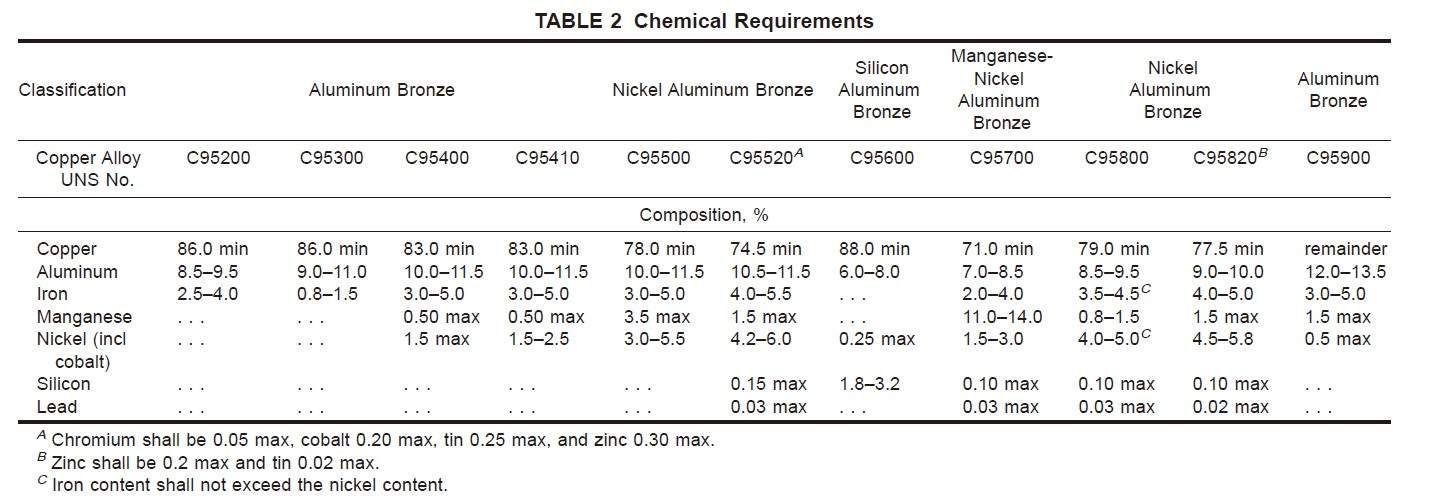
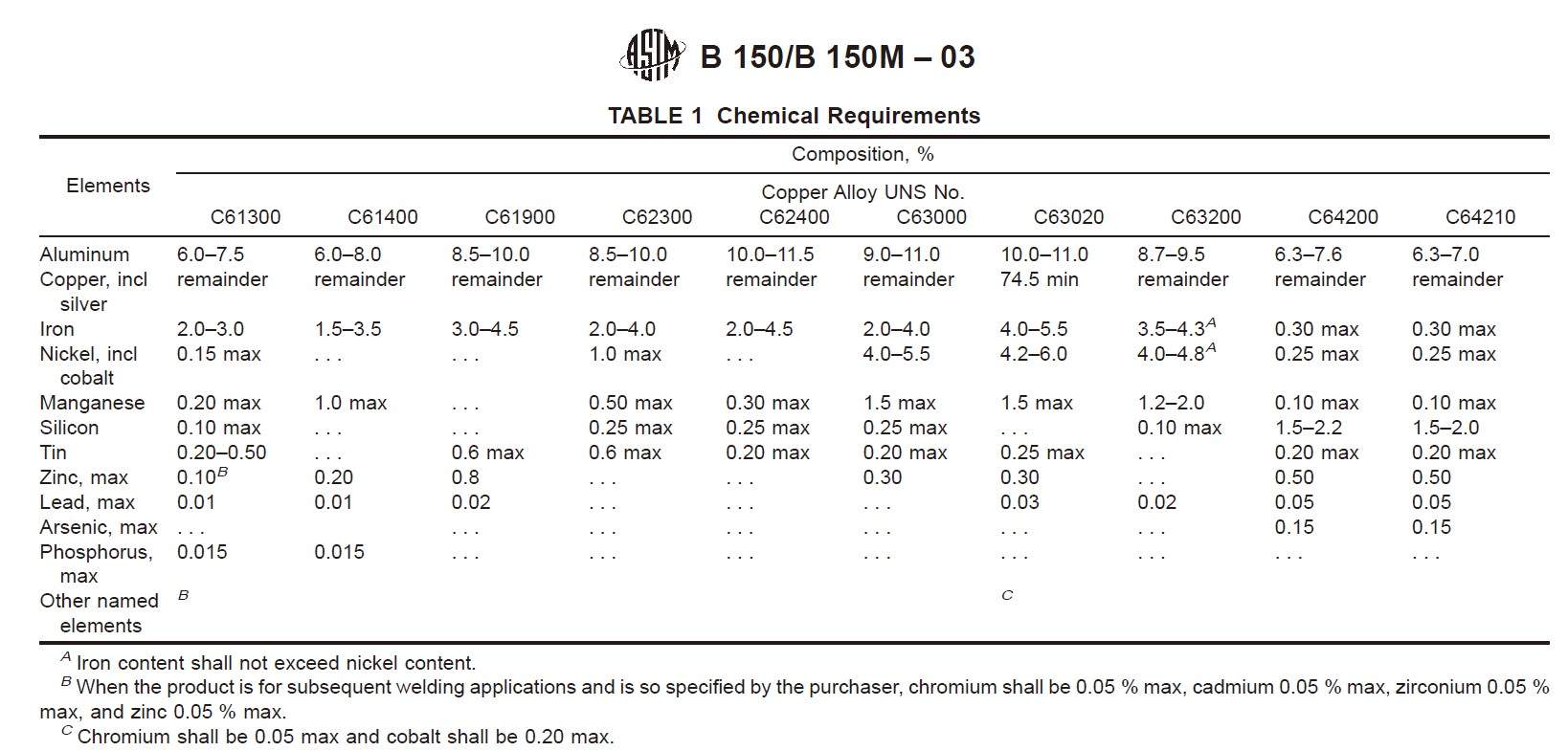
Advantages
Aluminum bronze alloys are definitely to be considered instead of titanium, duplex or super duplex alloys as they offer various advantages. Besides their high resistance to sea water corrosion, they have many other advantages:
Introduction
What is aluminum bronze? Sometimes, we call it nickel aluminum bronze. It is a copper based alloy with aluminum as the main alloy element. It's an aluminum bronze containing iron and manganese elements, which belongs to high-strength heat-resistant and corrosion resistant bronze.
Aluminum bronze valves are highly suitable for corrosive, saline environments. The common specification is ASTM B148 C95800 which is similar to C95500 and C95400, providing good castability, reasonable bearing materials, easy machining and high tensile strength. They are also a suitable and far cheaper substitute to duplex, super duplex and monel for applications to seawater, especially in low-pressure situations.
Material characteristics or properties
Aluminum bronze has high strength and good wear resistance. It is used for high-impact screws, nuts, copper sleeves, sealing rings, and wear-resistant parts. Its most outstanding feature is good wear resistance. The aluminum content of aluminum bronze is generally not more than 11.5%, and sometimes an appropriate amount of iron, nickel, manganese and other elements are added to further improve its performance. Aluminum bronze can be strengthened by heat treatment. Its strength is higher than that of tin bronze, and its high-temperature oxidation resistance is also better. It can improve the hardness after quenching and tempering, and has good high-temperature corrosion resistance and oxidation resistance, especially in the atmosphere, fresh water and sea water. Its machinability is good; it can be welded and not easy to be brazed; the hot pressure machining is good.
Valves in this special alloy are most valued for their exceptional corrosion resistance, toughness and strength compared to other bronze alloy valves. These alloys are tarnish-resistant and show low rates of corrosion in atmospheric conditions, low oxidation rates at high temperatures, and low reactivity with sulfurous compounds and other exhaust products of combustion. They are also resistant to corrosion in sea water, especially good for conditions with pitting corrosion, stress corrosion and corrosion fatigue.
The corrosion resistance of aluminum bronze lies in the aluminum component of the alloy, which reacts with atmospheric oxygen to form a thin, tough surface layer of aluminum oxide (alumina oxide) that acts as a corrosion barrier for copper-rich alloys.
Another remarkable feature of aluminum bronzes is their bio-static effects. The copper component of the alloy prevents colonization by marine organisms such as algae , lichens, barnacles, and mussels. Therefore, it can be preferable to stainless steel or other non-cupric alloys in special applications. Aluminum bronzes tend to be in golden color.
Compositions
Aluminum Bronze is a copper-based alloy, including aluminum, nickel and iron. Each component is adjusted to improve strength, corrosion resistance and machinability. The following tables list the compositions of the most common standard aluminum bronze, which are classified into standards ASTM B148 and ASTM B150.


Advantages
Aluminum bronze alloys are definitely to be considered instead of titanium, duplex or super duplex alloys as they offer various advantages. Besides their high resistance to sea water corrosion, they have many other advantages:
- High mechanical strength
- Low density (5% lighter than steel)
- Non sparking
- Low magnetic permeability
- High corrosion resistance, especially in the marine atmosphere
- Good stress corrosion properties
- Good cryogenic properties
- Good resistance to cavitation
- Good resistance to bio-fouling
- Being cheaper compared with Titanium
Applications
Aluminum bronzes are most often used in applications where corrosion resistance is superior to other engineered materials. These applications include plain bearings and landing gear components on aircraft, engine components, especially for seagoing ships, underwater fastenings in naval architecture, and ship propellers. Aluminum bronzes are in great demand from the following industries and areas:
- General sea water-related service
- Water supply
- Oil and petrochemical industries such as tools for non-sparking environments
- Professional anticorrosion applications
- Certain structural retrofit building
- Civil and military industry
Aluminum bronze can be welded by using the MIG welding technique with an Aluminum bronze core and pure argon gas. It can be electric welding and gas welding, but not easy to braze.


